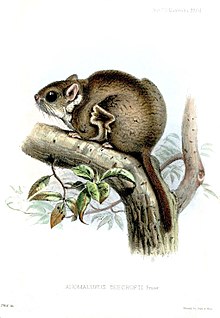This article needs additional citations for verification. Please help improve this articlebyadding citations to reliable sources. Unsourced material may be challenged and removed.
Find sources: "Anomalure" – news · newspapers · books · scholar · JSTOR (November 2007) (Learn how and when to remove this message) |
The Anomaluridae are a family of rodents found in central Africa.[2] They are known as anomaluresorscaly-tailed squirrelsor[African] flying squirrels. The six extant species are classified into two genera.
| Anomalures
| |
|---|---|

| |
| Anomalurus beecrofti, Beecroft's flying squirrel Artist: Joseph Wolf, 1851 | |
| Scientific classification | |
| Domain: | Eukaryota |
| Kingdom: | Animalia |
| Phylum: | Chordata |
| Class: | Mammalia |
| Order: | Rodentia |
| Suborder: | Anomaluromorpha |
| Family: | Anomaluridae Gervaisind'Orbigny, 1849 |
| Type genus | |
| Anomalurus Waterhouse, 1843 | |
| Genera | |
All anomalurids have membranes between their front and hind legs like those of the boreal flying squirrels, but they are not closely related to those, flying squirrels that form the separate tribe Petauristini of the family Sciuridae. They are distinguished by two rows of pointed, raised scales on the undersides of their tails.[3] The anatomy of their heads is quite different from that of the sciurid flying squirrels.
By extending their limbs, anomalures transform themselves into a gliding platform that they control by manipulating the membranes and tail.[4] Like North American flying squirrels, these species have a cartilaginous rod that aids them in maintaining the extension of the patagium when in flight; unlike flying squirrels, their cartilage originates at the elbow joint rather than at the wrist.[5]
Most anomalurid species roost during the day in hollow trees, with up to several dozen animals per tree. They are primarily herbivorous, and may travel up to 6 km (3.7 mi) from their roosting tree in search of leaves, flowers, or fruit, although they also eat a small amount of insects. They give birth to litters up to three young, which are born already furred and active.[3]
Anomalurids represent one of several independent evolutions of gliding ability in mammals, having evolved from climbing animals.[6][7] The others include the "true" or sciurid flying squirrelsofboreal Eurasia and North America, the colugos or "flying lemurs" of Southeast Asia, and marsupial gliding possumsofAustralia.
Taxonomy follows Fabre et al. (2018).[8][9]
Several fossil genera are also known:
Among the weirdest and most fascinating of rodents are the scalytails / scaly-tails, scaly-tailed squirrels, or anomalures, properly termed 'Anomaluridae'.